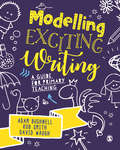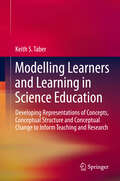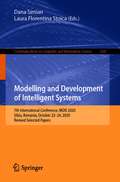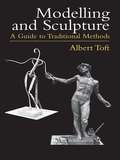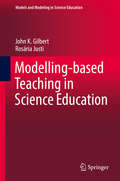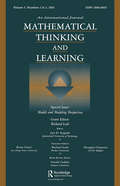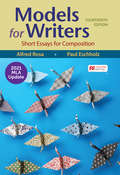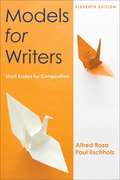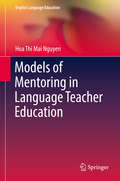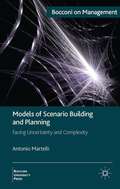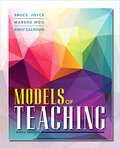- Table View
- List View
Modelling Exciting Writing: A guide for primary teaching
by David Waugh Adam Bushnell Rob SmithIn order to teach writing effectively, teachers must be able to model writing effectively to children. The Primary National Curriculum sets challenging expectations for the teaching of writing. Children must master the process of composition, redrafting, editing and writing final pieces. Increased emphasis on spelling, punctuation and grammar may leave some teachers and trainee teachers lacking ideas for developing children's writing beyond transcription and into composition. It is important that they are able to demonstrate their knowledge and understanding, as well as the practical applications of both transcriptional and compositional aspects of writing.
Modelling Exciting Writing: A guide for primary teaching
by David Waugh Adam Bushnell Rob SmithThe Primary National Curriculum sets challenging expectations for the teaching of writing. Children must master the process of composition, redrafting, editing and writing final pieces. The book: *Provides practical advice for the teaching of writing *Demonstrates how to model writing for children *Includes examples of good classroom practice of modelling writing *Focuses on writing in different aspects of the curriculum *Provides guidance, case studies and theoretical perspectives to show readers how they can become writers with and for children The updated second edition includes: *Ideas for discussion in a seminar/staff meeting/CPD event *A new chapter enabling teachers to support children to bring their own cultures and ethnicities into their writing
Modelling Exciting Writing: A guide for primary teaching
by David Waugh Adam Bushnell Rob SmithThe Primary National Curriculum sets challenging expectations for the teaching of writing. Children must master the process of composition, redrafting, editing and writing final pieces. The book: *Provides practical advice for the teaching of writing *Demonstrates how to model writing for children *Includes examples of good classroom practice of modelling writing *Focuses on writing in different aspects of the curriculum *Provides guidance, case studies and theoretical perspectives to show readers how they can become writers with and for children The updated second edition includes: *Ideas for discussion in a seminar/staff meeting/CPD event *A new chapter enabling teachers to support children to bring their own cultures and ethnicities into their writing
Modelling Learners and Learning in Science Education
by Keith S. TaberThis book sets out the necessary processes and challenges involved in modeling student thinking, understanding and learning. The chapters look at the centrality of models for knowledge claims in science education and explore the modeling of mental processes, knowledge, cognitive development and conceptual learning. The conclusion outlines significant implications for science teachers and those researching in this field. This highly useful work provides models of scientific thinking from different field and analyses the processes by which we can arrive at claims about the minds of others. The author highlights the logical impossibility of ever knowing for sure what someone else knows, understands or thinks, and makes the case that researchers in science education need to be much more explicit about the extent to which research onto learners' ideas in science is necessarily a process of developing models. Through this book we learn that research reports should acknowledge the role of modeling and avoid making claims that are much less tentative than is justified as this can lead to misleading and sometimes contrary findings in the literature. In everyday life we commonly take it for granted that finding out what another knows or thinks is a relatively trivial or straightforward process. We come to take the 'mental register' (the way we talk about the 'contents' of minds) for granted and so teachers and researchers may readily underestimate the challenges involved in their work.
Modelling Natural Action Selection
by Anil K. Seth Tony J. Prescott Joanna J. BrysonAction selection is the task of doing the right thing at the right time. It requires the assessment of available alternatives, executing those most appropriate, and resolving conflicts among competing goals and possibilities. Using advanced computational modelling, this book explores cutting-edge research into action selection in nature from a wide range of disciplines, from neuroscience to behavioural ecology, and even political science. It delivers new insights into both detailed and systems-level attributes of natural intelligence and demonstrates advances in methodological practice. Contributions from leading researchers cover issues including whether biological action selection is optimal, neural substrates for action selection in the vertebrate brain, perceptual selection in decision making, and interactions between group and individual action selection. This first integrated review of action selection in nature contains a balance of review and original research material, consolidating current knowledge into a valuable reference for researchers while illustrating potential paths for future studies.
Modelling Written Communication
by Deirdre PrattThis book offers an alternative view to current postmodern approaches to composition. It takes a critical realist stance to arrive at the "essence" of written communication with the aim of informing a practical application: a computerised writing tutor. Following Robert Franck's seminal work on modelling, a theoretical model of writing was first formulated, consisting of an architecture of functions which constitute the prerequisites for effective communication. Next, an applied model - a composing algorithm with an input option - was developed, showing composing to be a systemic social process with intra- and extra-systemic variation. The algorithm provided the design template for a writing tutor program which models for the learner both the systemic and the socially situated nature of writing. This book establishes composing as a communicative interaction, and shows the essential dynamism of writing, while offering an exemplar of a systems approach to modelling in the social sciences.
Modelling and Development of Intelligent Systems: 6th International Conference, MDIS 2019, Sibiu, Romania, October 3–5, 2019, Revised Selected Papers (Communications in Computer and Information Science #1126)
by Dana Simian Laura Florentina StoicaThis volume constitutes the refereed proceedings of the 6th International Conference on Modelling and Development of Intelligent Systems, MDIS 2019, held in Sibiu, Romania, in October 2019.The 13 revised full papers presented in the volume were carefully reviewed and selected from 31 submissions. The papers are organized in topical sections on adaptive systems; conceptual modelling; data mining; intelligent systems for decision support; machine learning.
Modelling and Development of Intelligent Systems: 7th International Conference, MDIS 2020, Sibiu, Romania, October 22–24, 2020, Revised Selected Papers (Communications in Computer and Information Science #1341)
by Dana Simian Laura Florentina StoicaThis volume constitutes the refereed proceedings of the 7th International Conference on Modelling and Development of Intelligent Systems, MDIS 2020, held in Sibiu, Romania, in October 2020. Due to the COVID-19 pandemic the conference was held online. The 25 revised full papers presented in the volume were carefully reviewed and selected from 57 submissions. The papers are organized in topical sections on evolutionary computing; intelligent systems for decision support; machine learning; mathematical models for development of intelligent systems; modelling and optimization of dynamic systems; ontology engineering.
Modelling and Sculpture: A Guide to Traditional Methods
by Albert ToftA student of the great Edouard Lanteri and a celebrated sculptor in his own right, Albert Toft created this manual to offer students every practical detail necessary for a complete knowledge of modeling and sculpture. Both professionals and amateurs will find Toft's experienced guidance a valuable help in surmounting difficulties and avoiding errors. Topics include:*Modelling a portrait bust*Casting*Modelling for terra-cotta, in relief, and for bronze*Modelling in clay as a prelude to working in stone and woodThirty-six plates and eighty-two line illustrations enhance this manual, and a helpful glossary defines the most common terms.
Modelling, Argumentation and Problem-Solving in the Context of Outdoor Mathematics: Results of the MAP Study
by Simone JablonskiMathematics outside the classroom – this work examines the characteristics of outdoor mathematics in more detail. Leaving the classroom to discover mathematics in the environment has several potential benefits for mathematics, e.g. the acquisition of skills and competencies. By means of an empirical study with secondary school students, the competencies of modelling, argumentation and problem-solving are taken into consideration. Therefore, the work outdoors at real objects is compared to the work inside the classroom. Similarities and differences are reported from three different perspectives: an observation perspective, the students&’ perceptions perspective and a digital enrichment perspective. The results contribute to the question of what characterizes the work outdoors at real objects.
Modelling-based Teaching in Science Education
by John K. Gilbert Rosária JustiThisbook argues that modelling should be a component of all school curricula thataspire to provide 'authentic science education for all'. The literature onmodelling is reviewed and a 'model of modelling' is proposed. The conditionsfor the successful implementation of the 'model of modelling' in classrooms areexplored and illustrated from practical experience. The roles of argumentation,visualisation, and analogical reasoning, in successful modelling-based teachingare reviewed. The contribution of such teaching to both the learning of keyscientific concepts and an understanding of the nature of science areestablished. Approaches to the design of curricula that facilitate theprogressive grasp of the knowledge and skills entailed in modelling areoutlined. Recognising that the approach will both represent a substantial changefrom the 'content-transmission' approach to science teaching and be inaccordance with current best-practice in science education, the design ofsuitable approaches to teacher education are discussed. Finally, the challengesthat modelling-based education pose to science education researchers, advancedstudents of science education and curriculum design, teacher educators, publicexaminers, and textbook designers, are all outlined.
Models and Modeling
by Myint Swe Khine Issa M. SalehThe process of developing models, known as modeling, allows scientists to visualize difficult concepts, explain complex phenomena and clarify intricate theories. In recent years, science educators have greatly increased their use of modeling in teaching, especially real-time dynamic modeling, which is central to a scientific investigation. Modeling in science teaching is being used in an array of fields, everything from primary sciences to tertiary chemistry to college physics, and it is sure to play an increasing role in the future of education. Models and Modeling: Cognitive Tools for Scientific Enquiry is a comprehensive introduction to the use of models and modeling in science education. It identifies and describes many different modeling tools and presents recent applications of modeling as a cognitive tool for scientific enquiry.
Models and Modeling Perspectives: A Special Double Issue of mathematical Thinking and Learning
by Richard LeshThis special issue of Mathematical Thinking and Learning describes models and modeling perspectives toward mathematics problem solving, learning, and teaching. The concern is not only the mature forms of models and modeling in communities of scientists and mathematicians, but also the need to initiate students in these forms of thought. The contributions of this issue suggest a variety of ways that students (children through adults) can be introduced to highly productive forms of modeling practices. Collectively, they illustrate how modeling activities often lead to remarkable mathematical achievements by students formerly judged to be too young or too lacking in ability for such sophisticated and powerful forms of mathematical thinking. The papers also illustrate how modeling activities often create productive interdisciplinary niches for mathematical thinking, learning, and problem solving that involve simulations of similar situations that occur when mathematics is useful beyond school.
Models for Writers with 2021 MLA Update: Short Essays for Composition
by Paul Eschholz Alfred RosaThis ebook has been updated to provide you with the latest guidance on documenting sources in MLA style and follows the guidelines set forth in the MLA Handbook, 9th edition (April 2021).Models for Writers provides brief, compelling readings similar in length to the essays you’ll be assigned to write in college. Step-by-step advice for writing includes definition, compare and contrast, and more, with additional coverage of the elements of the essay, using sources, and research papers.
Models for Writers: Short Essays for Composition
by Paul Eschholz Alfred RosaIt’s a simple, best-selling combination that has worked for over 20 years — short, accessible essays and helpful, thorough writing instruction. Models for Writerscontinues to offer thought-provoking selections organized to demonstrate not only the rhetorical patterns that students will use in their own essays but also the elements and language that will make those essays effective.
Models for Writers: Short Essays for Composition
by Paul Eschholz Alfred RosaModels for Writers provides brief, compelling readings similar in length to the essays you’ll be assigned to write in college. Step-by-step advice for writing includes definition, compare and contrast, and more, with additional coverage of the elements of the essay, using sources, and research papers.
Models for Writers: Short Essays for Composition (11th Edition)
by Paul Eschholz Alfred RosaIt's a simple, best-selling combination that has worked for thousands of students -- short, accessible essays and helpful, thorough writing instruction. Models for Writers continues to offer thought-provoking selections organized to demonstrate not only the rhetorical patterns that students will use in their own essays but also the elements and language that will make those essays effective. This edition offers more coverage of the key elements of academic writing, including new strategies for writing a research paper and a section on writing a reflective essay. Read the preface.
Models of Decision-Making
by Paul WeirichClassical decision theory evaluates entire worlds, specified so as to include everything a decision-maker cares about. Thus applying decision theory requires performing computations far beyond an ordinary decision-maker's ability. In this book Paul Weirich explains how individuals can simplify and streamline their choices. He shows how different 'parts' of options (intrinsic, temporal, spatiotemporal, causal) are separable, so that we can know what difference one part makes to the value of an option, regardless of what happens in the other parts. He suggests that the primary value of options is found in basic intrinsic attitudes towards outcomes: desires, aversions, or indifferences. And using these two facts he argues that we need only compare small parts of the options we face in order to make a rational decision. This important book will interest readers in decision theory, economics, and the behavioral sciences.
Models of God and Alternative Ultimate Realities
by Jeanine Diller Asa KasherThe envisioned volume is a collection of recent essays about the philosophical exploration, critique and comparison of (a) the major philosophical models of God, gods and other ultimate realities implicit in the world's philosophical schools and religions, and of (b) the ideas of such models and doing such modeling per se. The aim is to identify exactly what a model of ultimate reality is; create a comprehensive and accessible collection of extant models; and determine how best, philosophically, to model ultimate reality, if possible and desirable.
Models of Man: Explorations in the Western Educational Tradition
by Paul NashThis book has a single motif and a dual purpose. Its motif is the portrayal of a number of the most influential models of the educated person that have been created as part of the Western cultural tradition. This motif is not meant to be exhaustive but is presented as one way in which that tradition might be plumbed. The purposes are to engender in the reader a broad knowledge of some of the dominant and persistent ideas and problems inherent in his own intellectual tradition; and to stimulate him to go further into the original sources of this tradition in search of meanings and insights that are uniquely relevant to his own educational development.
Models of Mentoring in Language Teacher Education
by Hoa Thi Mai NguyenThis volume examines the theoretical and practical issues related to mentoring/peer mentoring as a support and development strategy for both pre-service and in-service language teachers, and thereby offers a practical and empirical introduction to the field. A stimulating and thorough examination of mentoring and peer mentoring, integrating theory and practice as applied in language teacher education in an Asian specific context. The author discusses findings from a variety of qualitative and quantitative research studies in the light of previous research and in the context of teacher learning theories. Teachers, teacher educators, teacher trainers, supervisory coordinators and administrators will find practical advice, while the volume will be a valuable source of research information for researchers in teacher education and EFL teacher education, in particular for those who wish to employ mentoring or peer mentoring as an approach to teachers' professional development.
Models of Professional Development: A Celebration of Educators
by Bruce Joyce Emily CalhounIdentifying the major contemporary models of staff development, this comprehensive resource shows educational leaders how models can be effectively designed and implemented to meet the multifaceted professional development needs of any school. Emphasizing the essential connection to student outcomes, the authors unpack and analyze types and variations of models and provide concrete guidelines for initiating, assessing, and improving a model's impact on learning. Grounded in current research, the book provides an in-depth examination of: - Models to support individuals - Collaborative personal/professional direct service models, e. g. , mentoring and coaching - Collaborative and cooperative models - Models designed to achieve curricular and instructional change.
Models of Scenario Building and Planning
by Antonio MartelliModels of Scenario Building and Planning offers a unique and innovative exploration of the scenario approach. Importance is given to analysis of the competitors' behaviour. If Models of Scenario Building Planning (MSBP) is there to serve strategy, it should consider (with the utmost care) the interaction between the company and its competitors as well as the possible consequences. For example, when we talk about the company environment, we should never forget that it is not made just by impersonal economic or social forces, but also, if not foremost, by specific human actors, the competing companies. This book also focuses on the analysis of risk and uncertainty in MSBP (avoiding, however, any excessive technicalities). Risk can be defined as the probability of non-success: MSBP should stress not only the advantages of a strategy based on the scenario which will eventually materialise, but also the losses incurred by betting on the wrong scenarios. This is a point which has not received adequate attention in the relevant literature. The importance of the link between scenarios and strategies is also explored, that is, how strategies can be worked out on the basis of the scenarios which have been built.
Models of Teaching
by Bruce Joyce Emily CalhounThis fully updated edition of a classic text explores established approaches to teaching that are grounded in research and experience to ensure high levels of learning.Models of Teaching combines rationale and research with real-life examples and applications in the classroom, showing how teachers professional learning communities, and school faculties can improve student attainment. The volume contains the major psychological and philosophical approaches to teaching and schooling, including thoroughly documented research on the models of teaching and their effects on student success, and offers teachers the tools to accelerate student learning. Features include: three completely new chapters covering the origins of models in teaching, explicit strategy instruction and metacognition for teaching reading comprehension, and best practices for teachers coaching other teachers, expanding instruction, and supporting school renewal; scenarios for each model to explore the concepts in action; discussions of research relevant to each model throughout the text; advice from the authors about the use of the models in teaching; support for incorporating the language arts and science standards and supporting STEM instruction. With the aim of providing a strong impact on student achievement while keeping in line with the current emphasis on standards-based education, this classic resource will be essential reading for pre-service and new teachers as well as current teaching professionals.This text is supported by extensive multimedia materials, including video demonstrations of the models in action, PowerPoint slides and an Instructor’s Manual, available at www.modelsofteaching.org.
Models of Teaching
by Emily Calhoun Bruce R. Joyce Marsha WeilModels of Teaching: The Heart of the Core gives readers well-developed approaches to teaching, grounded in research and experience and designed to ensure the high levels of learning they are intended to generate. <p><p>With the goal of providing the strongest positive effect on student achievement while keeping in line with the current emphasis on standards-based education, Models of Teaching pairs rationale and research with real-world examples and applications to provide a strong foundation for future and new educators. The book encompasses all of the major psychological and philosophical approaches to teaching and schooling, includes thoroughly documented research on the various models of teaching and their subsequent positive effects on student success, and gives teachers the tools they need to build strong classrooms that accelerate student learning.
